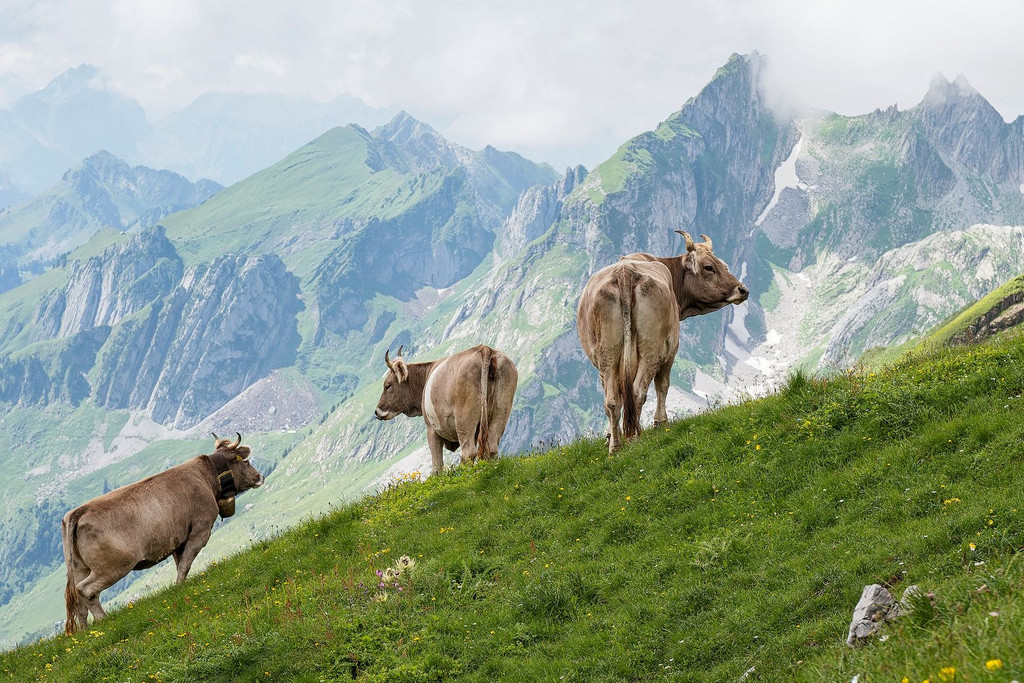It was a gathering under the cover of darkness when the three confederates met on the Rütli in 1291 to pledge an oath of alliance. Such a meeting would not be as straightforward today as authorisation would have to be obtained and the three valiant figures could only have conducted their affairs during the daytime as overnight stays on the famous meadow in the forest above Lake Uri are not permitted. And a “fully completed application” would have to be submitted today for such an emotive issue as an oath of confederate alliance. This is according to the regulations on the use of the birthplace of Switzerland issued on 9 January 2014 by the Swiss Society for Public Utility (SGG), which manages the Rütli site.
Times have changed, but one thing has remained the same despite the new regulations — the Rütli is simply a meadow and not a pompous national shrine. It is a national memorial site which exudes calm owing to its very simplicity. Halfway between the landing stage and the meadow, visitors can stop off at the Rütlihaus restaurant and enjoy a small exhibition and the Three-Countries Fountain. It is a rather remote plot of land which is only easily reached from the lake, an unspoilt location in a dramatic setting. Having arrived at the meadow, visitors are no longer sure whether they are captivated by the wonderful scenery alone or whether prior knowledge of the genius loci permeates their visual experience.
Not an historical site
This knowledge today also includes the recognition that there is little historicity surrounding the site. The historian Roger Sablonier writes that the elements of the founding myth, “the crimes of the rulers, conspiracy, Tell’s feat, the destruction of the castles and the popular uprising, were combined at the end of the 15th century to produce a picture story about the origins of the nation, but they have very little to absolutely nothing to do with actual events circa 1300. The founding myth was used in the post-1470 period as a literary and legal justification for the confederation’s special existence as a state at this time, rather than as an historically accurate account of historical events in the more distant past”.
For historians the Rütli has long since played an insignificant role as an historical site, just as William Tell plays an unimportant role. However, it still has a powerful impact as a tale steeped in history. In the new standard work “Geschichte der Schweiz” (History of Switzerland) published in 2014, Susanna Burghartz, professor of history at the University of Basel, writes: “Although this Tell never existed, he certainly played an historical role as a figure and, towards the end of the 15th century, was already part of the set of ideas to which an important integrative role was attributed in the emergence of federal consciousness and its legitimisation.” This “set of ideas” also included the Rütli.
The role of the myth
Historians recognise that legends and myths can play a positive role. Ulrich Im Hof, a former professor of Swiss history at the University of Berne, suggests that only positivistic thinking believes in “renouncing the myth and being able to dispense with an awareness of national identity”. This approach is problematic, he says, because “this vacuum created could be filled by other, more uncontrollable notions of identity”. The “components of national identity and their myths — provided they embody real values and are always analysed critically — remain essential to the existence of a political society”, writes Im Hof in his book entitled “Mythos Schweiz” (The Myth of Switzerland) in 1991.
The literary scholar Peter von Matt also believes myths play a fundamental political role. In his 1 August address on the Rütli in 2009, he said that for many people “this Rütli is a piece of national hokum. It is dismissed as a symbol of historical blindness, a phantom and a collective delusion”. But we should be careful as we have fallen into the trap in recent years of only asking the question of myth or reality? It is not quite that simple. The origins of all nations are condensed into exciting tales and “these tales play a major role. They are essentially political codes of conduct”. In the case of William Tell the message is: “Obedience in the state has its limits. The servile spirit should never gain the upper hand.” From the Rütli oath we might infer “that we in Switzerland do not need or want a chief”. In his address Peter von Matt also touched upon the Seelisberg tunnel which runs beneath the Rütli and is one of the major north-south links in Europe: “The Rütli stands for the will of the confederation to belong and remain together. The tunnel represents the equally strong desire to reach out beyond national borders and play a role in the interaction between the European powers.”
The Rütli can also quite plainly be seen as the location of a European dawn even without the tunnel — at least that was still true in 1991. Ulrich Bremi, the Free Democrat President of the National Council, remarked during the Swiss confederation’s 700-year anniversary celebrations back then: “The Rütli must now also become a platform for a modern European Switzerland. If we are serious about what the Rütli signifies, then we will today embrace the challenge of becoming a Switzerland with an open and a European outlook.” Some 5,000 invited guests, including all the European parliamentary speakers, listened to the celebratory address on the Rütli meadow. The Rütli spirit of 1991 has nevertheless failed to help Switzerland reach the great European heights outlined by Bremi. Let us turn our attention back to the past then.
From Friedrich Schiller to Henri Guisan
The Rütli — with the meadow above Lake Uri being visited by around 100,000 people a year — has not just become a popular national pilgrimage destination in recent times. The original cantons in particular continually held events there during the 17th and 18th centuries. However, there were three events in the 19th and 20th centuries that were of major myth-building significance: Friedrich Schiller’s play “William Tell” of 1804, the acquisition of the Rütli meadow by the Swiss Society for Public Utility (SGG) in 1859 and General Henri Guisan’s Rütli address in 1940.
The mythical founding event by Lake Lucerne was actually canonised and exaggerated in Schiller’s drama. Gioachino Rossini’s opera “William Tell”, which premiered in Paris in 1829, also contributed to its Europe-wide popularisation. The enthusiasm was initially greater abroad than in Switzerland. However, the revolutionary ideas did not escape the censorial authorities in Milan, Rome, London and St Petersburg, and they found themselves obliged to tone down the content in a few contentious places.
The meadow’s purchase by the SGG in 1859 triggered another Rütli boom. The money was raised through a national collection campaign. This prevented a touristic development project on the memorial site. The campaign was organised very effectively. Swiss youngsters were involved in the collection, and all school pupils received a steel engraving featuring a romanticised picture of the Rütli as a token of gratitude. The SGG donated the land to the Swiss confederation as an “inalienable national asset” which transferred it to the SGG’s Rütli Commission to manage it, and this remains the situation to this day.
The Rütli became a place steeped in symbolism and history thanks to Henri Guisan. The general assembled all senior officers from the rank of major upwards for the Rütli address on 25 July 1940. He outlined the reasons for the National Redoubt and vowed that the people and army would categorically resist Nazi Germany. The event occupies a special place in the Swiss collective consciousness. “In this historic event the mutually inspiring and supportive effect can be seen which emanates from the mythical quality of the location to the events held there and — conversely — from the use of the site to the site used,” as Georg Kreis, an historian from Basel, writes in his book “Schweizer Erinnerungsorte” (Swiss Memorial Sites).
Dual depiction of the Rütli at the Federal Palace
Interestingly, the Rütli as a symbol of the old confederation was also incorporated into the symbolism of the new federal state of 1848. The Rütli myth is immortalised twice at the Federal Palace in Berne — extremely prominently in the entrance hall where the three powerful, 24-ton confederates stand pledging an oath, and very subtly in the National Council chamber where the Rütli is captured in Charles Giron’s monumental painting “Wiege der Eidgenossenschaft” (Cradle of the Confederation).
The Rütli still occupies a prominent place in the imagination of many Swiss people. It was originally patriotic and nationalistic factions who recognised the symbolic value of the site at the heart of early Switzerland. A subliminal battle for interpretational sovereignty over the Rütli continually flares up today in which all social and political movements are involved. It is used by many groups as a surface onto which a wide range of issues are projected — for or against a Swiss policy of openness towards Europe, for peace and justice, for a strong army, against the left, against the right, and for democracy, etc.
While only simple federal celebrations tended to take place on the Rütli in the past, in recent times Federal Councillors have also used the sacred site for public appearances. Addresses by Federal Councillors were totally disrupted by neo-Nazis on two occasions, in 2000 and 2005. In 2007, Alliance F, the federation of Swiss women’s organisations, launched a new approach to “wrest the Rütli from the conservative, male-dominated world and nationalistic forces”, writes Georg Kreis. President of the Swiss Confederation Micheline Calmy-Rey (SP), President of the National Council Christine Egerszegy (FDP) and SGG President Judith Stamm (CVP) held a large joint 1 August celebration there.
Protection against misuse
A further indication of the vitality of the Rütli is the intensive media coverage given to all major events. The SVP executive address in 2011, which included an appearance by SVP Federal Councillor Ueli Maurer, received great attention. This event should not actually have been allowed to take place as political events are never held on the site. Shortly afterwards, CVP Federal Councillor Doris Leuthard was therefore not permitted to speak on the Rütli meadow at an event organised by the CVP cantonal parties. CVP National Councillor Ida Glanzmann subsequently submitted a postulate to the Federal Council requesting that the parties be given free access to the Rütli. The Swiss Society for Public Utility (SGG), as the body responsible for managing the Rütli, was therefore obliged to undertake a fundamental review of its usage. According to SGG Director Lukas Niederberger, no clear regulations concerning the political parties previously existed. The SGG now sought to prohibit all party events in light of the controversy. Following an intervention by the Federal Chancellery, the ban was not worded quite so stringently: Anniversary celebrations of parties can be held but the “Rütli must not be used for specific political objectives or commercial goals”. This is the wording in the new regulations on usage. Events which “address political issues that will be voted on in the next three months” and which promote specific persons or groups six months before elections, for example, are banned. The Rütli is also to be protected against political extremism as neo-Nazis constantly attempt to draw attention to themselves there. It must not be used for objectives which “bring into question the fundamental values of the Swiss confederation”, whereby tolerance towards people who hold different views is specifically mentioned. Activities “directed against certain persons or groups in Switzerland” and which “polarise public opinion and do not accept social and cultural diversity” are therefore prohibited.These guidelines make one thing clear – national memorials can be places of reflection. However, they always carry the risk of being misused for negative purposes owing to their great symbolic significance. The Rütli shares this fate with similar sites throughout the world.
Jürg Müller is an editor with “Swiss Review”














Comments
Comments :